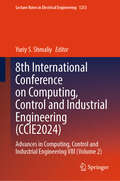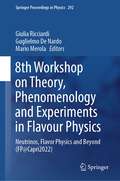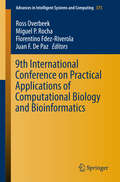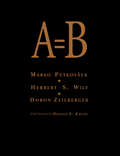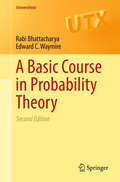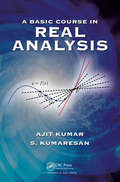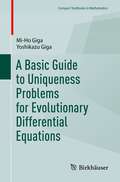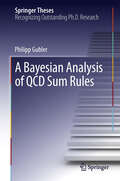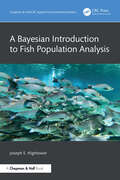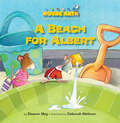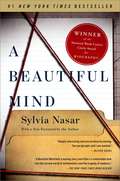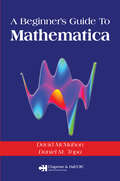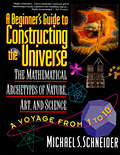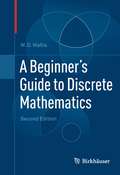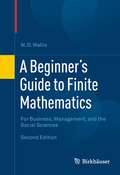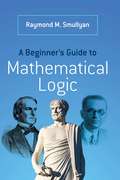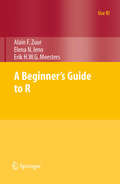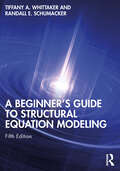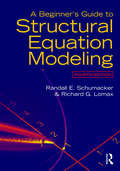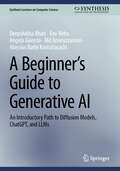- Table View
- List View
8th International Conference on Computing, Control and Industrial Engineering: Advances in Computing, Control and Industrial Engineering VIII (Volume 1) (Lecture Notes in Electrical Engineering #1252)
by Yuriy S. ShmaliyThis book collects selected aspects of recent advances and experiences, emerging technology trends that have positively impacted our world from operators, authorities, and associations from CCIE 2024, to help address the world’s advanced computing, control technology, information technology, artificial intelligence, machine learning, deep learning, and neural networks. Meanwhile, the topics included in the proceedings have high research value and present current insights, developments, and trends in computing, control, and industrial engineering.
8th International Conference on Computing, Control and Industrial Engineering: Advances in Computing, Control and Industrial Engineering VIII (Volume 2) (Lecture Notes in Electrical Engineering #1253)
by Yuriy S. ShmaliyThis book collects selected aspects of recent advances and experiences, emerging technology trends that have positively impacted our world from operators, authorities, and associations from CCIE 2024, to help address the world’s advanced computing, control technology, information technology, artificial intelligence, machine learning, deep learning, and neural networks. Meanwhile, the topics included in the proceedings have high research value and present current insights, developments, and trends in computing, control, and industrial engineering.
8th Workshop on Theory, Phenomenology and Experiments in Flavour Physics: Neutrinos, Flavor Physics and Beyond (FP@Capri2022) (Springer Proceedings in Physics #292)
by Giulia Ricciardi Guglielmo De Nardo Mario MerolaThis book is a collection of invited contributions presented at the 8th edition of the International Workshop on Theory, Phenomenology and Experiments in Flavour Physics, held on the Island of Capri, Italy, on 11–13 June 2022. It is a joint workshop between experimentalists and theoreticians aiming at debating recent results and hot topics in flavour physics, in an interdisciplinary effort. Flavour, electroweak physics and neutrino physics are all foremost in the assessment of results within the standard model and search for physics beyond. Anomalies in flavour physics are hints on new physics, while with neutrino masses and oscillations the new physics has already started. Contributions deal mainly with the flavour anomalies, the flavour problem from leptons to quarks and back, including continuous versus discrete symmetries, and the connections between the Higgs sector and neutrinos, embracing see-saw models and Higgs potential analyses. Focus is on neutrinos, at high and low scales, including LHC searches and CLVF, leptogenesis, connections with dark sectors and NP mediators, non-standard neutrino interactions and the problem of the nature of massive neutrinos.
9th European Medical and Biological Engineering Conference: Proceedings of EMBEC 2024, June 9-13, 2024, Portorož, Slovenia, Volume 2 (IFMBE Proceedings #113)
by Samo Mahnič-Kalamiza Tomaž Jarm Rok ŠmercThis book informs on new trends, challenges, and solutions, in the multidisciplinary field of biomedical engineering. It covers traditional topics in biomechanics and biomedical signal processing, as well as recent trends relating to the applications of artificial intelligence and IoT in healthcare, wearable devices for patient monitoring, monitoring of medical devices, machine learning applications in medical data, among others. Gathering the second volume of the proceedings of the 9th European Medical and Biological Engineering Conference (EMBEC 2024), held on June 9-13, 2024, in Portorož, Slovenia, this book bridges fundamental and clinically-oriented research, emphasizing the role of translational research in biomedical engineering. It aims at inspiring and fostering communication and collaboration between engineers, physicists, biologists, physicians and other professionals dealing with cutting-edge themes in and advanced technologies serving the broad field of biology and healthcare.
9th International Conference on Practical Applications of Computational Biology and Bioinformatics (Advances in Intelligent Systems and Computing #375)
by Ross Overbeek Miguel P. Rocha Florentino Fdez-Riverola Juan F. PazThis proceedings presents recent practical applications of Computational Biology and Bioinformatics. It contains the proceedings of the 9th International Conference on Practical Applications of Computational Biology & Bioinformatics held at University of Salamanca, Spain, at June 3rd-5th, 2015. The International Conference on Practical Applications of Computational Biology & Bioinformatics (PACBB) is an annual international meeting dedicated to emerging and challenging applied research in Bioinformatics and Computational Biology. Biological and biomedical research are increasingly driven by experimental techniques that challenge our ability to analyse, process and extract meaningful knowledge from the underlying data. The impressive capabilities of next generation sequencing technologies, together with novel and ever evolving distinct types of omics data technologies, have put an increasingly complex set of challenges for the growing fields of Bioinformatics and Computational Biology. The analysis of the datasets produced and their integration call for new algorithms and approaches from fields such as Databases, Statistics, Data Mining, Machine Learning, Optimization, Computer Science and Artificial Intelligence. Clearly, Biology is more and more a science of information requiring tools from the computational sciences.
A = B
by Marko Petkovsek Herbert S Wilf Doron ZeilbergerThis book is of interest to mathematicians and computer scientists working in finite mathematics and combinatorics. It presents a breakthrough method for analyzing complex summations. Beautifully written, the book contains practical applications as well as conceptual developments that will have applications in other areas of mathematics.From the ta
A Basic Course in Measure and Probability
by Ross LeadbetterOriginating from the authors' own graduate course at the University of North Carolina, this material has been thoroughly tried and tested over many years, making the book perfect for a two-term course or for self-study. It provides a concise introduction that covers all of the measure theory and probability most useful for statisticians, including Lebesgue integration, limit theorems in probability, martingales, and some theory of stochastic processes. Readers can test their understanding of the material through the 300 exercises provided. The book is especially useful for graduate students in statistics and related fields of application (biostatistics, econometrics, finance, meteorology, machine learning, and so on) who want to shore up their mathematical foundation. The authors establish common ground for students of varied interests which will serve as a firm 'take-off point' for them as they specialize in areas that exploit mathematical machinery.
A Basic Course in Probability Theory (Universitext)
by Rabi Bhattacharya Edward C. WaymireThis text develops the necessary background in probability theory underlying diverse treatments of stochastic processes and their wide-ranging applications. In this second edition, the text has been reorganized for didactic purposes, new exercises have been added and basic theory has been expanded. General Markov dependent sequences and their convergence to equilibrium is the subject of an entirely new chapter. The introduction of conditional expectation and conditional probability very early in the text maintains the pedagogic innovation of the first edition; conditional expectation is illustrated in detail in the context of an expanded treatment of martingales, the Markov property, and the strong Markov property. Weak convergence of probabilities on metric spaces and Brownian motion are two topics to highlight. A selection of large deviation and/or concentration inequalities ranging from those of Chebyshev, Cramer-Chernoff, Bahadur-Rao, to Hoeffding have been added, with illustrative comparisons of their use in practice. This also includes a treatment of the Berry-Esseen error estimate in the central limit theorem. The authors assume mathematical maturity at a graduate level; otherwise the book is suitable for students with varying levels of background in analysis and measure theory. For the reader who needs refreshers, theorems from analysis and measure theory used in the main text are provided in comprehensive appendices, along with their proofs, for ease of reference. Rabi Bhattacharya is Professor of Mathematics at the University of Arizona. Edward Waymire is Professor of Mathematics at Oregon State University. Both authors have co-authored numerous books, including a series of four upcoming graduate textbooks in stochastic processes with applications.
A Basic Course in Real Analysis
by Ajit Kumar S. KumaresanBased on the authors' combined 35 years of experience in teaching, A Basic Course in Real Analysis introduces students to the aspects of real analysis in a friendly way. The authors offer insights into the way a typical mathematician works observing patterns, conducting experiments by means of looking at or creating examples, trying to understand t
A Basic Course in Topology (Compact Textbooks in Mathematics)
by Gerd Laures Markus SzymikThis book serves as an introduction to topology, a branch of mathematics that studies the qualitative properties of geometric objects. It is designed as a bridge between elementary courses in analysis and linear algebra and more advanced classes in algebraic and geometric topology, making it particularly suitable for both undergraduate and graduate mathematics students. Additionally, it can be used for self-study. The authors employ the modern language of category theory to unify and clarify the concepts presented, with definitions supported by numerous examples and illustrations. The book includes over 170 exercises that reinforce and deepen the understanding of the material. Many sections feature brief insights into advanced topics, providing a foundation for study projects or seminar presentations. In addition to set-theoretic topology, the book covers essential concepts such as fundamental groups, covering spaces, bundles, sheaves, and simplicial methods, which are vital in contemporary geometry and topology.
A Basic Guide to Uniqueness Problems for Evolutionary Differential Equations (Compact Textbooks in Mathematics)
by Yoshikazu Giga Mi-Ho GigaThis book addresses the issue of uniqueness of a solution to a problem – a very important topic in science and technology, particularly in the field of partial differential equations, where uniqueness guarantees that certain partial differential equations are sufficient to model a given phenomenon. This book is intended to be a short introduction to uniqueness questions for initial value problems. One often weakens the notion of a solution to include non-differentiable solutions. Such a solution is called a weak solution. It is easier to find a weak solution, but it is more difficult to establish its uniqueness. This book examines three very fundamental equations: ordinary differential equations, scalar conservation laws, and Hamilton-Jacobi equations. Starting from the standard Gronwall inequality, this book discusses less regular ordinary differential equations. It includes an introduction of advanced topics like the theory of maximal monotone operators as well as what is called DiPerna-Lions theory, which is still an active research area. For conservation laws, the uniqueness of entropy solution, a special (discontinuous) weak solution is explained. For Hamilton-Jacobi equations, several uniqueness results are established for a viscosity solution, a kind of a non-differentiable weak solution. The uniqueness of discontinuous viscosity solution is also discussed. A detailed proof is given for each uniqueness statement. The reader is expected to learn various fundamental ideas and techniques in mathematical analysis for partial differential equations by establishing uniqueness. No prerequisite other than simple calculus and linear algebra is necessary. For the reader’s convenience, a list of basic terminology is given at the end of this book.
A Bayesian Analysis of QCD Sum Rules (Springer Theses)
by Philipp GublerThe author develops a novel analysis method for QCD sum rules (QCDSR) by applying the maximum entropy method (MEM) to arrive at an analysis with less artificial assumptions than previously held. This is a first-time accomplishment in the field. In this thesis, a reformed MEM for QCDSR is formalized and is applied to the sum rules of several channels: the light-quark meson in the vector channel, the light-quark baryon channel with spin and isospin 1/2, and several quarkonium channels at both zero and finite temperatures. This novel technique of combining QCDSR with MEM is applied to the study of quarkonium in hot matter, which is an important probe of the quark-gluon plasma currently being created in heavy-ion collision experiments at RHIC and LHC.
A Bayesian Introduction to Fish Population Analysis (Chapman & Hall/CRC Applied Environmental Statistics)
by Joseph E. HightowerFisheries science is an applied field. A biologist working on a depleted population might need to forecast the population trajectory or examine which factors are limiting recovery. For an exploited population, a biologist might investigate whether the fishery or the stock would be improved through harvest regulation, such as a quota or size limit. Addressing those sorts of questions generally involves estimating parameters such as population size or survival rate. An essential step is characterizing the degree of uncertainty in results, which can be substantial for fisheries models. Bayesian methods and current software provide a flexible and powerful framework for addressing these challenges. Models developed using Bayesian software can be tailored to the unique aspects of each field study.A Bayesian Introduction to Fish Population Analysis is aimed at advanced undergraduate and graduate students as well as working professionals interested in a hands-on introduction to Bayesian approaches for fitting fisheries models. Chapters address key aspects of population dynamics: abundance, mortality, growth, and recruitment. The book includes complete R code for simulating each study design and JAGS Bayesian code for model fitting; code files are also available online. No prior knowledge of R or JAGS is assumed and new commands are introduced gradually through the sequence of examples. There is emphasis throughout the book on how to vary simulation settings to develop intuition about fisheries models (e.g., how many fish should be tagged in order to obtain usefully precise results). Additional topics include development of integrated population models, model checking, model selection, and uninformative and informative prior distributions.Key features include: The book begins with a focus on ecologically relevant probability distributions (e.g. binomial, Poisson, normal, lognormal) as a foundation for the applied fisheries chapters. Subsequent chapters demonstrate Bayesian approaches for estimating abundance, mortality, growth, and recruitment. Full open-source code is provided for simulation and plotting using R and Bayesian model fitting using JAGS. The book demonstrates how simulation can be used to gain a deeper understanding of analytical methods and for planning field studies. Joseph E. Hightower is a professor emeritus in the Department of Applied Ecology at NCState University. His research interests focus on fish population dynamics, especially field andanalytical methods for estimating population parameters. His primary teaching role was agraduate course in quantitative fisheries management, including Bayesian methods that serveas the foundation for this book.
A Beach for Albert: Capacity (Mouse Math)
by Eleanor MayEach read-aloud book in the Mouse Math series focuses on a single, basic math concept and features adorable mice, Albert and Wanda, who live in a People House. Entertaining fiction stories capture kids&’ imaginations as the mice learn about numbers, shapes, sizes and more. Over 3 million copies sold worldwide!When the People go away to the beach, Albert decides to make a beach of his own in the backyard sandbox. The only problem is—how to fill up his "beach" with water? Every Mouse Math title includes back matter activities that support and extend reading comprehension and math skills, plus free online activities. (Math concept: Volume/Capacity)
A Beautiful Mind (Shooting Script Ser.)
by Sylvia Nasar**Also an Academy Award–winning film starring Russell Crowe and Jennifer Connelly—directed by Ron Howard** The powerful, dramatic biography of math genius John Nash, who overcame serious mental illness and schizophrenia to win the Nobel Prize.“How could you, a mathematician, believe that extraterrestrials were sending you messages?” the visitor from Harvard asked the West Virginian with the movie-star looks and Olympian manner. “Because the ideas I had about supernatural beings came to me the same way my mathematical ideas did,” came the answer. “So I took them seriously.” Thus begins the true story of John Nash, the mathematical genius who was a legend by age thirty when he slipped into madness, and who—thanks to the selflessness of a beautiful woman and the loyalty of the mathematics community—emerged after decades of ghostlike existence to win a Nobel Prize for triggering the game theory revolution. The inspiration for an Academy Award–winning movie, Sylvia Nasar’s now-classic biography is a drama about the mystery of the human mind, triumph over adversity, and the healing power of love.
A Beginner's Guide To Mathematica
by David McMahon Daniel M. TopaBecause of its large command structure and intricate syntax, Mathematica can be difficult to learn. Wolfram's Mathematica manual, while certainly comprehensive, is so large and complex that when trying to learn the software from scratch -- or find answers to specific questions -- one can be quickly overwhelmed.A Beginner's Guide to Mathemat
A Beginner's Guide to Constructing the Universe: The Mathematical Archetypes of Nature, Art, and Science
by Michael S. SchneiderDiscover how mathematical sequences abound in our natural world in this definitive exploration of the geography of the cosmosYou need not be a philosopher or a botanist, and certainly not a mathematician, to enjoy the bounty of the world around us. But is there some sort of order, a pattern, to the things that we see in the sky, on the ground, at the beach? In A Beginner's Guide to Constructing the Universe, Michael Schneider, an education writer and computer consultant, combines science, philosophy, art, and common sense to reaffirm what the ancients observed: that a consistent language of geometric design underpins every level of the universe, from atoms to galaxies, cucumbers to cathedrals. Schneider also discusses numerical and geometric symbolism through the ages, and concepts such as periodic renewal and resonance. This book is an education in the world and everything we can't see within it.Contains numerous b&w photos and illustrations.
A Beginner's Guide to Discrete Mathematics
by W. D. WallisWallis's book on discrete mathematics is a resource for an introductory course in a subject fundamental to both mathematics and computer science, a course that is expected not only to cover certain specific topics but also to introduce students to important modes of thought specific to each discipline . . . Lower-division undergraduates through graduate students. --Choice reviews (Review of the First Edition) Very appropriately entitled as a 'beginner's guide', this textbook presents itself as the first exposure to discrete mathematics and rigorous proof for the mathematics or computer science student. --Zentralblatt Math (Review of the First Edition) This second edition of A Beginner's Guide to Discrete Mathematics presents a detailed guide to discrete mathematics and its relationship to other mathematical subjects including set theory, probability, cryptography, graph theory, and number theory. This textbook has a distinctly applied orientation and explores a variety of applications. Key Features of the second edition: * Includes a new chapter on the theory of voting as well as numerous new examples and exercises throughout the book * Introduces functions, vectors, matrices, number systems, scientific notations, and the representation of numbers in computers * Provides examples which then lead into easy practice problems throughout the text and full exercise at the end of each chapter * Full solutions for practice problems are provided at the end of the book This text is intended for undergraduates in mathematics and computer science, however, featured special topics and applications may also interest graduate students.
A Beginner's Guide to Finite Mathematics: For Business, Management, and the Social Sciences
by W. D. WallisThis second edition of A Beginner's Guide to Finite Mathematics takes a distinctly applied approach to finite mathematics at the freshman and sophomore level. Topics are presented sequentially: the book opens with a brief review of sets and numbers, followed by an introduction to data sets, histograms, means and medians. Counting techniques and the Binomial Theorem are covered, which provides the foundation for elementary probability theory; this, in turn, leads to basic statistics. This new edition includes chapters on game theory and financial mathematics. Requiring little mathematical background beyond high school algebra, the text will be especially useful for business and liberal arts majors.
A Beginner's Guide to Mathematical Logic
by Raymond M. SmullyanCombining stories of great writers and philosophers with quotations and riddles, this completely original text for first courses in mathematical logic examines problems related to proofs, propositional logic and first-order logic, undecidability, and other topics. 2013 edition.
A Beginner's Guide to R: A Frequentist And Bayesian Perspective For Ecologists (Use R!)
by Elena N. Ieno Alain Zuur Erik MeestersBased on their extensive experience with teaching R and statistics to applied scientists, the authors provide a beginner's guide to R. To avoid the difficulty of teaching R and statistics at the same time, statistical methods are kept to a minimum. The text covers how to download and install R, import and manage data, elementary plotting, an introduction to functions, advanced plotting, and common beginner mistakes. This book contains everything you need to know to get started with R. "Its biggest advantage is that it aims only to teach R...It organizes R commands very efficiently, with much teaching guidance included. I would describe this book as being handy--it's the kind of book that you want to keep in your jacket pocket or backpack all the time, ready for use, like a Swiss Army knife." (Loveday Conquest, University of Washington) "Whilst several books focus on learning statistics in R..., the authors of this book fill a gap in the market by focusing on learning R whilst almost completely avoiding any statistical jargon...The fact that the authors have very extensive experience of teaching R to absolute beginners shines throughout." (Mark Mainwaring, Lancaster University) "Exactly what is needed...This is great, nice work. I love the ecological/biological examples; they will be an enormous help." (Andrew J. Tyne, University of Nebraska-Lincoln)
A Beginner's Guide to Structural Equation Modeling
by Tiffany A. Whittaker Randall E. SchumackerA Beginner’s Guide to Structural Equation Modeling, fifth edition, has been redesigned with consideration of a true beginner in structural equation modeling (SEM) in mind. The book covers introductory through intermediate topics in SEM in more detail than in any previous edition. All of the chapters that introduce models in SEM have been expanded to include easy-to-follow, step-by-step guidelines that readers can use when conducting their own SEM analyses. These chapters also include examples of tables to include in results sections that readers may use as templates when writing up the findings from their SEM analyses. The models that are illustrated in the text will allow SEM beginners to conduct, interpret, and write up analyses for observed variable path models to full structural models, up to testing higher order models as well as multiple group modeling techniques. Updated information about methodological research in relevant areas will help students and researchers be more informed readers of SEM research. The checklist of SEM considerations when conducting and reporting SEM analyses is a collective set of requirements that will help improve the rigor of SEM analyses. This book is intended for true beginners in SEM and is designed for introductory graduate courses in SEM taught in psychology, education, business, and the social and healthcare sciences. This book also appeals to researchers and faculty in various disciplines. Prerequisites include correlation and regression methods.
A Beginner's Guide to Structural Equation Modeling: Fourth Edition
by Richard G. Lomax Randall E. SchumackerNoted for its crystal clear explanations, this book is considered the most comprehensive introductory text to structural equation modeling (SEM). Noted for its thorough review of basic concepts and a wide variety of models, this book better prepares readers to apply SEM to a variety of research questions. Programming details and the use of algebra are kept to a minimum to help readers easily grasp the concepts so they can conduct their own analysis and critique related research. Featuring a greater emphasis on statistical power and model validation than other texts, each chapter features key concepts, examples from various disciplines, tables and figures, a summary, and exercises. Highlights of the extensively revised 4th edition include: -Uses different SEM software (not just Lisrel) including Amos, EQS, LISREL, Mplus, and R to demonstrate applications. -Detailed introduction to the statistical methods related to SEM including correlation, regression, and factor analysis to maximize understanding (Chs. 1 - 6). -The 5 step approach to modeling data (specification, identification, estimation, testing, and modification) is now covered in more detail and prior to the modeling chapters to provide a more coherent view of how to create models and interpret results (ch. 7). -More discussion of hypothesis testing, power, sampling, effect sizes, and model fit, critical topics for beginning modelers (ch. 7). - Each model chapter now focuses on one technique to enhance understanding by providing more description, assumptions, and interpretation of results, and an exercise related to analysis and output (Chs. 8 -15). -The use of SPSS AMOS diagrams to describe the theoretical models. -The key features of each of the software packages (Ch. 1). -Guidelines for reporting SEM research (Ch. 16). -www.routledge.com/9781138811935 which provides access to data sets that can be used with any program, links to other SEM examples, related readings, and journal articles, and more. Reorganized, the new edition begins with a more detailed introduction to SEM including the various software packages available, followed by chapters on data entry and editing, and correlation which is critical to understanding how missing data, non-normality, measurement, and restriction of range in scores affects SEM analysis. Multiple regression, path, and factor models are then reviewed and exploratory and confirmatory factor analysis is introduced. These chapters demonstrate how observed variables share variance in defining a latent variables and introduce how measurement error can be removed from observed variables. Chapter 7 details the 5 SEM modeling steps including model specification, identification, estimation, testing, and modification along with a discussion of hypothesis testing and the related issues of power, and sample and effect sizes.Chapters 8 to 15 provide comprehensive introductions to different SEM models including Multiple Group, Second-Order CFA, Dynamic Factor, Multiple-Indicator Multiple-Cause, Mixed Variable and Mixture, Multi-Level, Latent Growth, and SEM Interaction Models. Each of the 5 SEM modeling steps is explained for each model along with an application. Chapter exercises provide practice with and enhance understanding of the analysis of each model. The book concludes with a review of SEM guidelines for reporting research. Designed for introductory graduate courses in structural equation modeling, factor analysis, advanced, multivariate, or applied statistics, quantitative techniques, or statistics II taught in psychology, education, business, and the social and healthcare sciences, this practical book also appeals to researchers in these disciplines. Prerequisites include an introduction to intermediate statistics that covers correlation and regression principles.
A Beginner's Guide to Teaching Mathematics in the Undergraduate Classroom
by Suzanne KeltonThis practical, engaging book explores the fundamentals of pedagogy and the unique challenges of teaching undergraduate mathematics not commonly addressed in most education literature. Professor and mathematician, Suzanne Kelton offers a straightforward framework for new faculty and graduate students to establish their individual preferences for course policy and content exposition, while alerting them to potential pitfalls. The book discusses the running of day-to-day class meetings and offers specific strategies to improve learning and retention, as well as concrete examples and effective tools for class discussion that draw from a variety of commonly taught undergraduate mathematics courses. Kelton also offers readers a structured approach to evaluating and honing their own teaching skills, as well as utilizing peer and student evaluations. Offering an engaging and clearly written approach designed specifically for mathematicians, A Beginner’s Guide to Teaching Mathematics in the Undergraduate Classroom offers an artful introduction to teaching undergraduate mathematics in universities and community colleges. This text will be useful for new instructors, faculty, and graduate teaching assistants alike.
A Beginner’s Guide to Generative AI: An Introductory Path to Diffusion Models, ChatGPT, and LLMs (Synthesis Lectures on Computer Science)
by Deepshikha Bhati Fnu Neha Angela Guercio Md Amiruzzaman Aloysius Bathi KasturiarachiThis book is the essential guide for anyone curious about AI’s creative power. In the rapidly evolving landscape of artificial intelligence, generative AI stands out as one of the most transformative technologies of our time. Designed for beginners and requiring no prior knowledge of AI, this book breaks down the fundamentals of generative AI, from text and image generation to the workings of models like ChatGPT and Google Bard. The authors provide step-by-step coverage of the essential concepts and techniques that power generative AI. From the basics of how machines learn to generate text and images, to the intricate workings of models like Transformers, ChatGPT, and Google Bard, readers will gain a solid foundation in AI's most cutting-edge tools. Rather than focusing on a single method, the authors introduce a spectrum of generative modeling techniques, including diffusion models, variational autoencoders, and transformers. This comprehensive exposure ensures readers will be well-prepared to understand and adapt to the rapidly evolving AI landscape. In addition, real-world applications of generative AI across various industries are explored including healthcare innovations, business analytics, and legal technology, and the authors provide practical insights and examples that show how generative AI is revolutionizing these fields.

